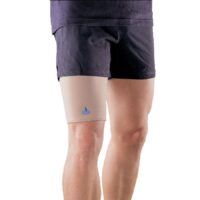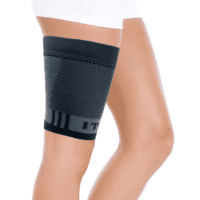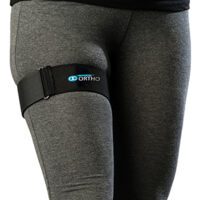Hip Labral Tear
Hip Labral Tear
What is a Hip Labral Tear?
A hip labral tear involves damage to the labrum, a ridge of cartilage that encircles the rim of your hip joint socket. This structure deepens the socket, providing greater stability to the hip joint. When the labrum tears, it can cause pain, clicking, or catching sensations in the hip.
Why Do Hip Labral Tears Occur?
Hip labral tears occur for several reasons:
- Injury: Direct trauma, often from falls or sporting activities, can lead to a tear. Sports that involve high-impact movements or rotations, like tennis, ice hockey, and soccer, are common culprits.
- Structural Changes: Changes to the shape of the femur or hip socket can cause premature contact, leading to a tear. Conditions such as Femoroacetabular Impingement Syndrome (FAIS) or Perthes Disease often contribute to these structural alterations.
- Degenerative Issues: As part of the osteoarthritic process, the labrum can deteriorate due to increased pressure on the joint. This degeneration exacerbates the cycle of cartilage loss and joint surface damage.
How Do You Know if You Have a Hip Labral Tear?
Hip labral tears can manifest in various ways. Common symptoms include:
- Hip pain
- Stiffness in the hip joint
- Pain in the groin or buttock regions
- Clicking or locking of the hip
- Instability or a sense of unsteadiness when standing on one leg
If these symptoms are present, especially during activities requiring hip rotation or bending, it’s essential to seek an assessment from a physiotherapist.
What Causes Hip Labral Tears?
Most hip labral tears arise from one of the following:
- Injury: Acute trauma or repetitive stress, especially in sports, can damage the labrum.
- Structural Changes: Abnormal hip joint anatomy increases the likelihood of labral damage.
- Degenerative Issues: Osteoarthritis and related joint deterioration contribute to labral tears over time.
How is a Hip Labral Tear Diagnosed?
Diagnosis usually involves a combination of symptom assessment and physical examination by a physiotherapist. Restricted hip movement often indicates a problem. An MRI, MRA, or arthroscopic surgery may be necessary for a definitive diagnosis.

Can You Fix a Torn Labrum Without Surgery?
Non-surgical management of labral tears involves physiotherapy-led exercises to strengthen the hip and surrounding muscles. Emerging evidence suggests that this approach can significantly reduce pain and improve function. Surgery is considered only if physiotherapy fails to alleviate symptoms.
Latest Research
Recent studies highlight the effectiveness of non-surgical treatments for hip labral tears, particularly in young and middle-aged adults. A review by Kawai et al. (2022) suggests that non-surgical management often yields outcomes comparable to surgical options.
Hip Labral Tear Treatment
Phase I – Pain Reduction & Labrum Protection:
Initial treatment focuses on reducing pain and avoiding activities that aggravate the injury. This includes:
- Avoiding sitting with knees lower than hips.
- Not crossing legs or sitting on them.
- Avoiding overextension of the hip.
Phase II – Restoring Flexibility & Strength:
Once pain subsides, the focus shifts to restoring movement and strengthening the hip:
- Assess and improve joint range of motion.
- Strengthen muscles around the hip.
- Enhance proprioception and joint position sense.
Phase III – Returning to Activity or Sport:
Gradually, activities are reintroduced:
- Focus on functional activities of daily living.
- Participate in a sport-specific return-to-play program.
- Seek physiotherapist guidance for safe return to sports.
Hip Labral Tear Surgery
In some cases, conservative treatment may not suffice, and surgery becomes necessary. This procedure typically involves re-attaching the labrum or removing the torn section. Post-surgery rehabilitation with a physiotherapist is crucial for a successful recovery.
What to Do?
If you experience symptoms of a hip labral tear, consult a physiotherapist for a thorough evaluation. Early intervention can help manage pain and prevent further injury.
Rochedale - Call 38410277
Book Online: RochedaleSalisbury - Call 32751044
Book Online: SalisburySandgate - Call 32691122
Book Online: SandgateRelated Articles
- Hip Pain: Discover the common causes of hip pain and effective treatment options.
- Femoroacetabular Impingement (FAI): Learn how FAI contributes to hip labral tears and what you can do about it.
- Hip Osteoarthritis: Explore the link between hip osteoarthritis and hip labral tears.
- Groin Pain: Understand how groin pain relates to hip labral tears and effective remedies.
- Sports Injuries: Learn about sports injuries, including labral tears, and how to prevent them.
- Mayo Clinic – Hip Labral Tear: A comprehensive guide to hip labral tears, including symptoms, causes, and treatment options.
- Cleveland Clinic – Hip Labral Tear: Detailed information on diagnosis, treatment, and recovery from hip labral tears.
- Johns Hopkins Medicine – Hip Labral Tear: Learn about the latest research and treatment approaches for hip labral tears.































































